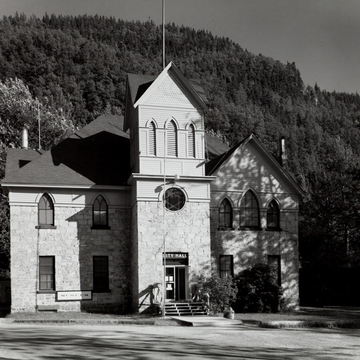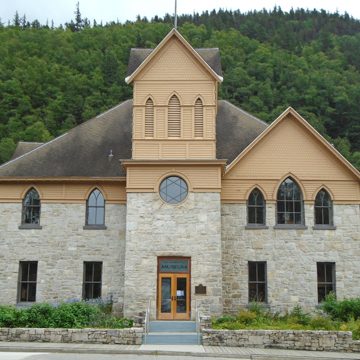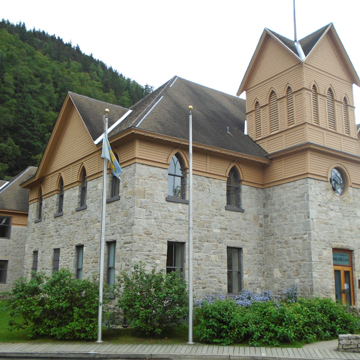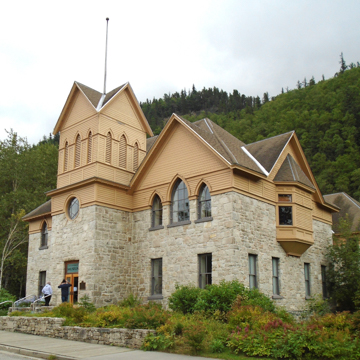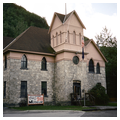You are here
City Hall (Trail of 98 Museum)
One of the few stone buildings in Alaska, Skagway's city hall began as a Methodist school but served for over fifty years as a federal courthouse. The two-story building is constructed of random-course granite in three colors. The basement of gray granite is topped by a 16-inch band of green granite, above which are the white granite walls. Halfway up the second story, the structure turns to wood frame and is finished with clapboards. The hipped roof has a cross gable on each side. A square tower, centered on the front, houses the stairwell and supports a louvered belfry. The Gothic-arch windows on the second story, fish-scale shingles in the gables, and an oriel window on the south contribute to the variety of forms and textures.
The Methodist school was the brainchild of Rev. J. J. Walter, superintendent of missions in Alaska for the Methodist church. When he arrived in Skagway in the summer of 1899, local Methodists were scraping together money to build a church. Walter felt that Skagway, with four hundred children and no public school, had more need for a school than for a church. In addition, a school would be easier to fund and could contain a chapel for community use. Walter soon raised $5,000, and ground was broken on 23 August 1899. The school, to be named after Bishop C. C. McCabe, would have four classrooms on the first floor, each measuring 28 feet by 19 feet. The second floor would hold a chapel and two recitation rooms, all of which could be opened into one auditorium.
Just at the time the school was ready to open in the fall of 1900, the U.S. Congress adopted legislation enabling license fees and taxes to support public schools in incorporated towns in Alaska. Suddenly, a Methodist school was no longer necessary. Walter sold the newly completed school building to the U.S. District Court for $9,000. After paying what was owed, the Methodists had $5,000 with which to build a church.
The U.S. District Court occupied the building, using the second floor as a courtroom, until the 1950s, when the City of Skagway acquired it. Municipal offices occupy the first floor, while the second floor houses a museum.
Writing Credits
If SAH Archipedia has been useful to you, please consider supporting it.
SAH Archipedia tells the story of the United States through its buildings, landscapes, and cities. This freely available resource empowers the public with authoritative knowledge that deepens their understanding and appreciation of the built environment. But the Society of Architectural Historians, which created SAH Archipedia with University of Virginia Press, needs your support to maintain the high-caliber research, writing, photography, cartography, editing, design, and programming that make SAH Archipedia a trusted online resource available to all who value the history of place, heritage tourism, and learning.


